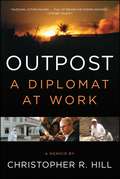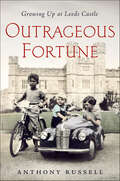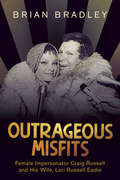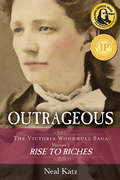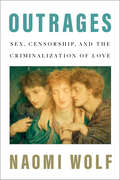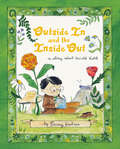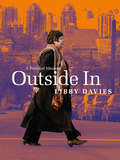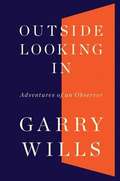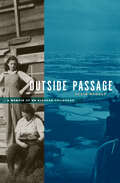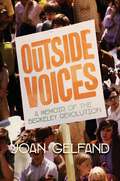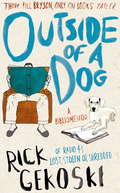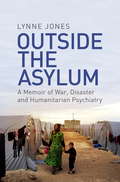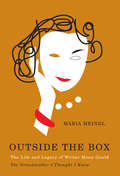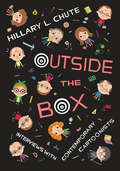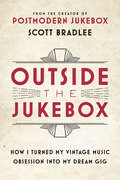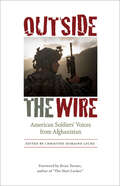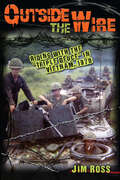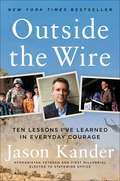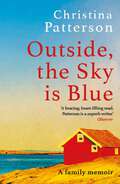- Table View
- List View
Outpost
by Christopher R. HillAn "inside the room" memoir from one of our most distinguished ambassadors who--in a career of service to the country--was sent to some of the most dangerous outposts of American diplomacy. From the wars in the Balkans to the brutality of North Korea to the endless war in Iraq, this is the real life of an American diplomat.Hill was on the front lines in the Balkans at the breakup of Yugoslavia. He takes us from one-on-one meetings with the dictator Milosevic, to Bosnia and Kosovo, to the Dayton conference, where a truce was brokered. Hill draws upon lessons learned as a Peace Corps volunteer in Cameroon early on in his career and details his prodigious experience as a US ambassador. He was the first American Ambassador to Macedonia; Ambassador to Poland, where he also served in the depth of the cold war; Ambassador to South Korea and chief disarmament negotiator in North Korea; and Hillary Clinton's hand-picked Ambassador to Iraq. Hill's account is an adventure story of danger, loss of comrades, high stakes negotiations, and imperfect options. There are fascinating portraits of war criminals (Mladic, Karadzic), of presidents and vice presidents (Clinton, Bush and Cheney, and Obama), of Secretaries of State (Madeleine Albright, Colin Powell, Condoleezza Rice, and Hillary Clinton), of Secretary of Defense Robert Gates, and of Ambassadors Richard Holbrooke and Lawrence Eagleburger. Hill writes bluntly about the bureaucratic warfare in DC and expresses strong criticism of America's aggressive interventions and wars of choice.
Outrageous Acts and Everyday Rebellions, Second Edition
by Gloria SteinemMost of these essays were originally published in Ms. Magazine in the 1970s and early 1980s. In many cases Steinem has added postscripts to update the material and to describe how the original article was received. The subject matter ranges widely. In one piece Steinem celebrates the life of her mother, who battled mental illness for decades. In "I Was a Playboy Bunny" she describes a week working at the Playboy Club as an undercover reporter. In the section called Five Women Steinem reflects on the lives and legacies of such figures as Jacqueline Kennedy Onassis, Marilyn Monroe, and Linda Lovelace. One piece is an outcry again the horrors of female genital mutilation.
Outrageous Fortune: Growing Up at Leeds Castle
by Anthony RussellIn his stunning memoir, Outrageous Fortune, Anthony Russell takes us inside his childhood growing up at Leeds Castle, with luxury and opulence few can imagine, and how he found his way in a changing society."I was lucky with lineage. Money, and lots of it, appeared to grow on trees, especially those which adorned the Leeds Castle parkland. Ancestors with glowing titles and extraordinary accomplishments filled the history books, but there would be consequences for being handed everything of a material nature on a plate, with no clear indication of what one might be expected to do with such good fortune."Leeds Castle has long been hailed as the loveliest castle in the world. Originally built in the twelfth century as a Norman stronghold, the castle once housed Kings and Queens, but fell into disrepair for nearly a century, until Anthony Russell's grandmother, Lady Baillie, purchased it in 1926 and restored the fortress to its former glory. It was in the castle's fairytale setting, surrounded by a moat and acres of sprawling grounds, that Anthony spent his childhood in the 1950s.It was a life of spectacular beauty and privilege, but for a shy boy often lonely and fraught with the fear of breaking some unwritten rule of the Castle Way. As Anthony reveals in his extraordinarily vivid and frank memoir, such a childhood was perhaps not the best preparation for modern life beyond the castle's walls. By the end of the 1960s, the polite reserve of the Castle Way was starting to give way to unconventional music, manners, and social freedom-simultaneously alluring and alarming to a young man who had grown up in splendid isolation in a world that would soon be gone.
Outrageous Misfits: Female Impersonator Craig Russell and His Wife, Lori Russell Eadie
by Brian BradleyLights! Camera! Outrageous! Superstar female impersonator Craig Russell and the birth of drag on the international stage. Craig Russell was an internationally admired entertainer and actor, known for his outrageous impersonations of some of Hollywood's greatest female celebrities: Mae West, Barbra Streisand, Bette Midler, Carol Channing, and Judy Garland, to name a few. Lori Russell Eadie, a shy theatre lover, was Craig's No. 1 fan and, eventually, his wife. Together they were fun, fabulous, and eschewed convention. But behind the curtains, Craig and Lori's lives were troubled by their mental health, drug addiction, sexual assault, and abuse. Through nearly one hundred interviews and extensive research, Outrageous Misfits reveals the life and legacy of one of the world's most popular female impersonators and his biggest fan.
Outrageous: Rise to Riches (The Victoria Woodhull Saga #1)
by Victor Villaseñor Neal KatzWomen empowerment, overcoming adversity, social change, and hope were the cornerstones upon which Victoria Woodhull (1838–1927) and her younger sister Tennessee Celeste Claflin built their incredible lives in Victorian America. OUTRAGEOUS, Rise to Riches sets the psychological verity and traces Victoria from childhood poverty and horrific abuse to becoming one of the wealthiest women in America, founding the first women-owned brokerage firm on Wall Street, and the first women-owned newspaper. Victoria will stop at nothing to achieve her destiny. Neal Katz' debut novel, winner of 12 literary awards, is a historical fictionalized account of Victoria Woodhull's rise to presidential candidate and wealth, coming from poverty and abuse. Volume One of The Victoria Woodhull Saga tells the poignant, lascivious, and compelling inside story of how the sisters worked closely with Cornelius Vanderbilt, who at age 74 fell in love with the beguiling 24-year old Tennessee. Victoria provided the titan of industry "Inside Her Information" gathered through the soiled sisterhood, the ladies of the evening working at the top seven brothels servicing the rich and famous of New York City. This relationship resulted in the great lion of industry having his last public roar as together they manipulated the financial markets and created the impending collapse of the U.S. economy in the gold scandal of 1869. To avert the crash, President Ulysses S. Grant provides the richest man in America insider information on the gold market and telegrams Vanderbilt that his railroad company is "Too Big To Fail!" Vanderbilt was proclaimed "The Savior of the American Economy" for intervening in a crisis he helped create. View Victorian America through the eyes and thoughts of one of its leading heroines., Victoria Woodhull. Watch as the infighting and elitism of the earliest suffrage women denigrating, castigating, and denouncing other passionate suffrage rights women delayed woman suffrage and equal legal standing for five decades. Learn wonderful anecdotes of the origins of products and phrases used today. Learn the story of Reverend Henry Ward Beecher, the most popular man in America, who transformed Christianity from his father's "fire and brimstone" theology to one of a compassionate and loving Jesus, who will redeem all who turn to salvation with complete confession of their sins. The reverend's personal life did not imitate his lofty and popular theology of his weekly sermons at Plymouth Church. He was a notorious womanizer, often bedding, and sometimes impregnating the wives, sisters, and daughters of his most ardent trackers and deacons of the church. Written in the first person from Victoria's viewpoint, Neal Katz weaves a compelling page-turning story that cleverly unfolds history while providing a wonderfully entertaining ride.
Outrages: Sex, Censorship, and the Criminalization of Love
by Naomi WolfOutrages: Sex, Censorship, and the Criminalization of Love
Outrages: Sex, Censorship, and the Criminalization of Love
by Naomi WolfFrom New York Times bestselling author Naomi Wolf, Outrages explores the history of state-sponsored censorship and violations of personal freedoms through the inspiring, forgotten history of one writer&’s refusal to stay silenced.In 1857, Britain codified a new civil divorce law and passed a severe new obscenity law. An 1861 Act of Parliament streamlined the harsh criminalization of sodomy. These and other laws enshrined modern notions of state censorship and validated state intrusion into people&’s private lives.In 1861, John Addington Symonds, a twenty-one-year-old student at Oxford who already knew he loved and was attracted to men, hastily wrote out a seeming renunciation of the long love poem he&’d written to another young man.Outrages chronicles the struggle and eventual triumph of Symonds—who would become a poet, biographer, and critic—at a time in British history when even private letters that could be interpreted as homoerotic could be used as evidence in trials leading to harsh sentences under British law.Drawing on the work of a range of scholars of censorship and of LGBTQ+ legal history, Wolf depicts how state censorship, and state prosecution of same-sex sexuality, played out—decades before the infamous trial of Oscar Wilde—shadowing the lives of people who risked in new ways scrutiny by the criminal justice system. She shows how legal persecutions of writers, and of men who loved men affected Symonds and his contemporaries, including Christina and Dante Gabriel Rossetti, Algernon Charles Swinburne, Walter Pater, and the painter Simeon Solomon. All the while, Walt Whitman&’s Leaves of Grass was illicitly crossing the Atlantic and finding its way into the hands of readers who reveled in the American poet&’s celebration of freedom, democracy, and unfettered love.Inspired by Whitman, and despite terrible dangers he faced in doing so, Symonds kept trying, stubbornly, to find a way to express his message—that love and sex between men were not &“morbid&” and deviant, but natural and even ennobling.He persisted in various genres his entire life. He wrote a strikingly honest secret memoir—which he embargoed for a generation after his death—enclosing keys to a code that the author had used to embed hidden messages in his published work. He wrote the essay A Problem in Modern Ethics that was secretly shared in his lifetime and would become foundational to our modern understanding of human sexual orientation and of LGBTQ+ legal rights. This essay is now rightfully understood as one of the first gay rights manifestos in the English language.Naomi Wolf&’s Outrages is a critically important book, not just for its role in helping to bring to new audiences the story of an oft-forgotten pioneer of LGBTQ+ rights who could not legally fully tell his own story in his lifetime. It is also critically important for what the book has to say about the vital and often courageous roles of publishers, booksellers, and freedom of speech in an era of growing calls for censorship and ever-escalating state violations of privacy. With Outrages, Wolf brings us the inspiring story of one man&’s refusal to be silenced, and his belief in a future in which everyone would have the freedom to love and to speak without fear.
Outside In and the Inside Out: A Story About Arnold Lobel
by Emmy KastnerA thoughtful and whimsical picture book about Arnold Lobel, award-winning creator of Frog and Toad.Arnold Lobel was many things: a quiet observer, an avid reader, and the kind of man who kept a gorilla suit in his closet, just in case. Above all else, Arnold was an artist and a storyteller. And he infused pieces of himself in the characters he created. This made sharing his books with the world scary sometimes—but his stories would go on to inspire and delight readers and live on in their hearts for generations.A rare window into the life and work of Arnold Lobel, creator of the Frog and Toad series, Outside In and the Inside Out captures the iconic creator of some of the most beloved children's books of all time.
Outside In: A Political Memoir
by Libby DaviesLibby Davies has worked steadfastly for social justice both inside parliament and out on the streets for more than four decades. At nine-teen, Davies became a community organizer in Vancouver’s Downtown Eastside. She went on to serve in municipal and then federal politics, advancing to the role of Deputy Leader of the New Democratic Party. Davies looks back on her remarkable life and career with candid humour and heart-rending honesty. She addresses the challenges of her work on homelessness, sex workers’ rights, and ending drug prohibition. She illuminates the human strengths and foibles at the core of each issue, her own as well as those of her colleagues and activist allies. Davies’ astute political analysis offers an insider’s perspective that never loses touch with the people she fights alongside. Outside In is both a political and personal memoir of Davies’ forty years of work at the intersection of politics and social movements.
Outside Looking In: Adventures of an Observer
by Garry WillsA captivating memoir from the incomparable Garry Wills, "one of the country's most distinguished intellectuals" (The New York Times Book Review) Illuminating and provocative, Outside Looking In is a compelling chronicle of an original thinker at work in remarkable times. With his dazzling style and journalist's eye for detail, Garry Wills brings history to life. Whether writing about the civil rights movement, 1960s protests, or close-up studies of the people who have shaped our world, only he could bring together in one book Barry Goldwater, Daniel Berrigan, Beverly Sills, Richard Nixon, and John Waters. Wills shares, as only the best raconteurs can, stories of the fascinating people he has closely observed during more than fifty years of reporting. .
Outside Passage: A Memoir of an Alaskan Childhood
by Julia ScullyWhen Julia Scully was seven years old, her father committed suicide, and she and her sister were sent to an orphanage. Two years later, emotionally damaged by the isolation and brutality of the orphanage, the girls followed their mother to the near-wilderness of the gold-mining territory north of Nome, Alaska, where she had leased a roadhouse in the tiny settlement of Taylor. Julia had no idea what to expect when she arrived, but to her surprise, she found a healing power in the stark beauty of the vast tundra. Later, she reveled in the boisterous, chaotic boomtown atmosphere that prevailed when thousands of American troops descended on Nome at the outbreak of World War II. Outside Passage is a lyrical and affecting memoir of those years, simultaneously an emotional account of a young girl’s first steps into adulthood and a unique portrait of a vanished frontier life.
Outside Voices: A Memoir of the Berkeley Revolution
by Joan GelfandBerkeley, 1972: a hotbed of creativity where painters, filmmakers, musicians, and writers inspire a young poet.Second-wave feminism, inspired by Gloria Steinem, Bella Abzug, and Betty Friedan is swelling into a tsunami. Women are joining together to change power dynamics in politics, the home, and the workplace. On election day, Joan Gelfand casts her vote for George McGovern and boards a plane from New York to California. With one introduction to a woman musician, Joan&’s journey to become a writer is born. Embraced by a thriving women&’s community of artists, filmmakers, musicians, poets, and writers, Joan is encouraged to find her voice. Mentored by paradigm-changing writers, Joan finds the courage to face her darkest fears through poetry and art, mining the trauma she experienced after losing her father and questioning her Jewish identity. Reminiscent of Paris in the twenties, Greenwich Village in the sixties, and Berlin in the eighties, Berkeley in the seventies was the &“it&” city of America. Outside Voices reports the ups and downs of finding one&’s way as an artist, living with a women&’s band, forging an independent Jewish identity, founding a women&’s restaurant, and becoming a published writer and songwriter while exploring the limits of sexuality and spirituality. The story includes road trips to music festivals in the woods, beaches in Mexico, concerts in Southern California, and a retreat in the Pacific Northwest. A triumphant story of determination and will, Outside Voices is a backstage look at the women&’s movement that sets the stage for decades of change. This book is a firsthand look at how the power of community emboldened innovation, social change, and self-discovery.
Outside of a Dog: A Bibliomemoir
by Rick GekoskiOutside of a dog, a book is man's best friend. Inside of a dog, it's too dark to read. Groucho MarxOutside of a Dog is the captivating account of twenty-five books drawn from the fields of literature, psychology and philosophy, and a memoir of a reading self.Tracing the formative role books have played in his life, Rick Gekoski trains the same ironic and analytic eye on these books and their authors as he does on himself. The result is unique: a sustained, witty book dedicated to the proposition that we are what we read. Outside of A Dog might be described as an intellectual bibliomemoir, except that the author regards the noun 'intellectual' as a term of abuse.Gekoski's twenty-five include: Dr. Seuss, Horton Hatches the Egg; Magnus Hirschfeld Sexual Anomalies and Perversions; Allen Ginsberg, Howl; J.D. Salinger, The Catcher in the Rye; T.S. Eliot, The Waste Land; Descartes, Meditations; David Hume, An Inquiry Concerning Human Understanding; W.B. Yeats, The Collected Poems; F.R. Leavis, The Common Pursuit; Matthew Arnold, Culture and Anarchy; Tom Wolfe, The Electric Kool-Aid Acid Test; Ludwig Wittgenstein, Philosophical Investigations; R.D. Laing, The Divided Self; Germaine Greer, The Female Eunuch; D.H. Lawrence, Women in Love; A.S. Neill, Summerhill; Roald Dahl, Matilda; Alice Miller, Pictures of a Childhood; A.J. Ayer, Language, Truth, and Logic; Sigmund Freud, The Interpretation of Dreams; Carl Hiaasen, Double Whammy; Peter Wright, Spycatcher; and Rick Gekoski, Staying Up.
Outside of a Dog: A Bibliomemoir
by Rick GekoskiOutside of a dog, a book is man's best friend. Inside of a dog, it's too dark to read. Groucho MarxOutside of a Dog is the captivating account of twenty-five books drawn from the fields of literature, psychology and philosophy, and a memoir of a reading self.Tracing the formative role books have played in his life, Rick Gekoski trains the same ironic and analytic eye on these books and their authors as he does on himself. The result is unique: a sustained, witty book dedicated to the proposition that we are what we read. Outside of A Dog might be described as an intellectual bibliomemoir, except that the author regards the noun 'intellectual' as a term of abuse.Gekoski's twenty-five include: Dr. Seuss, Horton Hatches the Egg; Magnus Hirschfeld Sexual Anomalies and Perversions; Allen Ginsberg, Howl; J.D. Salinger, The Catcher in the Rye; T.S. Eliot, The Waste Land; Descartes, Meditations; David Hume, An Inquiry Concerning Human Understanding; W.B. Yeats, The Collected Poems; F.R. Leavis, The Common Pursuit; Matthew Arnold, Culture and Anarchy; Tom Wolfe, The Electric Kool-Aid Acid Test; Ludwig Wittgenstein, Philosophical Investigations; R.D. Laing, The Divided Self; Germaine Greer, The Female Eunuch; D.H. Lawrence, Women in Love; A.S. Neill, Summerhill; Roald Dahl, Matilda; Alice Miller, Pictures of a Childhood; A.J. Ayer, Language, Truth, and Logic; Sigmund Freud, The Interpretation of Dreams; Carl Hiaasen, Double Whammy; Peter Wright, Spycatcher; and Rick Gekoski, Staying Up.
Outside the Asylum: A Memoir of War, Disaster and Humanitarian Psychiatry
by Lynne Jones'A profound memoir' Daily Telegraph'As revealing as the writing of Oliver Sacks' Mark CousinsOutside the Asylum is Lynne Jones's personal and highly acclaimed exploration of humanitarian psychiatry and the changing world of international relief. Her memoir graphically describes her experiences in war zones and disasters around the world, from the Balkans and 'mission-accomplished' Iraq, to tsunami-affected Indonesia, post-earthquake Haiti and 'the Jungle' in Calais.
Outside the Asylum: A Memoir of War, Disaster and Humanitarian Psychiatry
by Lynne JonesWhat happens if the psychiatric hospital in which you have lived for ten years is bombed and all the staff run away? What is it like to be a twelve-year-old and see all your family killed in front of you? Is it true that almost everyone caught up in a disaster is likely to suffer from post-traumatic stress disorder? What can mental health professionals do to help? How does one stay neutral and impartial in the face of genocide? Why would a doctor support military intervention?Outside the Asylum is Lynne Jones's personal exploration of of humanitarian psychiatry and the changing world of international relief; a memoir of more than twenty-five years as a practising psychiatrist in war and disaster zones around the world. From her training in one of Britain's last asylums, to treating traumatised soldiers in Gorazde after the Bosnian war, helping families who lost everything in the earthquake in Haiti, and learning from traditional healers in Sierra Leone, Lynne has worked with extraordinary people in extraordinary situations. This is a book that shines a light on the world of humanitarian aid, and that shows us the courage and resilience of the people who have to live, work and love in some of the most frightening situations in the world.
Outside the Box
by Maria MeindlYears later, Maria took on the daunting task of sorting through Mona's mountain of papers to create an archive for the University of Toronto's Fisher Rare Book Library. The chaotic state of the boxes reflected Mona's flamboyant and demanding personality, yet they also drew an important picture of the life of a Canadian freelancer in the twentieth century. Mona had begun publishing poetry and features in newspapers in the 1920s and published three books of poetry in the 1940s. In the 1950s, at a time when many women were retreating from the public sphere, she had a successful radio career. Her later journals and letters recount, in agonizing detail, a downward spiral into self-doubt, poverty, and addiction. Maria soon discovered that the truth of Mona's life was even more fascinating than her stories. Outside the Box brings to life a thinly documented era in Canadian letters through the story of one passionate and conflicted woman. It also charts the journey of an unwilling archivist, coming to terms with family secrets, forgotten history, and the stories that are never told.
Outside the Box: Interviews with Contemporary Cartoonists
by Hillary L. ChuteWe are living in a golden age of cartoon art. Never before has graphic storytelling been so prominent or garnered such respect: critics and readers alike agree that contemporary cartoonists are creating some of the most innovative and exciting work in all the arts. For nearly a decade Hillary L. Chute has been sitting down for extensive interviews with the leading figures in comics, and with Outside the Box she offers fans a chance to share her ringside seat. Chute’s in-depth discussions with twelve of the most prominent and accomplished artists and writers in comics today reveal a creative community that is richly interconnected yet fiercely independent, its members sharing many interests and approaches while working with wildly different styles and themes. Chute’s subjects run the gamut of contemporary comics practice, from underground pioneers like Art Spiegelman and Lynda Barry, to the analytic work of Scott McCloud, the journalism of Joe Sacco, and the extended narratives of Alison Bechdel, Charles Burns, and more. They reflect on their experience and innovations, the influence of peers and mentors, the reception of their art and the growth of critical attention, and the crucial place of print amid the encroachment of the digital age. Beautifully illustrated in full-color, and featuring three never-before-published interviews—including the first published conversation between Art Spiegelman and Chris Ware—Outside the Box will be a landmark volume, a close-up account of the rise of graphic storytelling and a testament to its vibrant creativity.
Outside the Box: The Life and Legacy of Writer Mona Gould, the Grandmother I Thought I Knew
by Maria MeindlYears later, Maria took on the daunting task of sorting through Mona's mountain of papers to create an archive for the University of Toronto's Fisher Rare Book Library. The chaotic state of the boxes reflected Mona's flamboyant and demanding personality, yet they also drew an important picture of the life of a Canadian freelancer in the twentieth century. Mona had begun publishing poetry and features in newspapers in the 1920s and published three books of poetry in the 1940s. In the 1950s, at a time when many women were retreating from the public sphere, she had a successful radio career. Her later journals and letters recount, in agonizing detail, a downward spiral into self-doubt, poverty, and addiction. Maria soon discovered that the truth of Mona's life was even more fascinating than her stories. Outside the Box brings to life a thinly documented era in Canadian letters through the story of one passionate and conflicted woman. It also charts the journey of an unwilling archivist, coming to terms with family secrets, forgotten history, and the stories that are never told.
Outside the Jukebox: How I Turned My Vintage Music Obsession into My Dream Gig
by Scott BradleeFrom the creator of the sensation Postmodern Jukebox--with millions of fans globally--comes an inspirational memoir about discovering what you love and turning it into a creative movement. With student loan debt piling up and no lucrative gigs around the corner, Scott Bradlee found himself in a situation all too familiar to struggling musicians and creative professionals, unsure whether he should use the little income he had to pay the rent on his basement apartment on the fringes of New York City or to avoid defaulting on his loans. It was under these desperate circumstances that Bradlee began experimenting, applying his passion for jazz, ragtime, and doo wop styles to contemporary hits by singers like Macklemore and Miley Cyrus--and suddenly an idea was born. The bands Bradlee went on to launch--from A Motown Tribute to Nickelback to Postmodern Jukebox, the rotating supergroup devoted to period covers of pop songs for which he is best known--borrowed from and refined the initial idea he had arrived at to bring genres now sometimes considered arcane to wide audiences. Today, the success he has had is astonishing, with Postmodern Jukebox collecting upwards of three million subscribers on YouTube, selling out major venues around the world, and developing previously unknown talent into superstar singers. Taking readers through the false starts, absurd failures, and unexpected breakthroughs of Bradlee's journey from a lost musician to a musical kingmaker headlining Radio City Music Hall--and presenting all the insights he learned along the way to becoming an entrepreneur like no other--OUTSIDE THE JUKEBOX is an inspiring memoir about how one musician found his rhythm and launched a movement that would forever change how people make, distribute, and enjoy their favorite songs.
Outside the Southern Myth
by Noel PolkLike many other southern men, Noel Polk doesn't fit the outside world's stereotype of the southern male. This notable Faulkner critic is a native of the small Mississippi city of Picayune. In his career as an international scholar and traveler and in his role as a teacher and a professor of literature, he has moved beyond his origins while continuing to be nourished by his hometown roots.“I almost invariably see myself depicted in the media as either a beer-drinking, mean-spirited, pickup-driving redneck racist; a julep-sipping, plantation-owning, kind-hearted, benevolent racist; or, at best, a nonracist good ole boy, one of several variations of Forrest Gump, good-hearted and retarded, who makes his way in the modern world not because he is intelligent but because he's—well, good hearted.”In Outside the Southern Myth Polk offers an apologia for a huge segment of southern males and communities that don't belong in the media portraits. His town was not antebellum. There were no plantations. No Civil War battles were fought there. It had little racial divisiveness. It was one of the thousands that mushroomed along the railroads as a response to logging and milling industries. It was mainly middle-class, not reactionary or exclusive.While evoking both the pleasures and the problems of his past—band trips, a yearning for cityscapes, religious conversion, awakening to the realities of fundamentalist fervor—Polk offers himself, his family, and his town to exemplify an aspect that is more “American” than “southern” and a tradition that is not mired in the past. As he explores the ways in which his experience of the South defined him, he concludes that his life has been experienced in a parallel universe, not in a time warp. He and many like him exist outside the southern myth.
Outside the Wire: American Soldiers' Voices from Afghanistan
by Christine Dumaine LecheA riveting collection of thirty-eight narratives by American soldiers serving in Afghanistan, Outside the Wire offers a powerful evocation of everyday life in a war zone. Christine Dumaine Leche—a writing instructor who left her home and family to teach at Bagram Air Base and a forward operating base near the volatile Afghan-Pakistani border—encouraged these deeply personal reflections, which demonstrate the power of writing to battle the most traumatic of experiences.The soldiers whose words fill this book often met for class with Leche under extreme circumstances and in challenging conditions, some having just returned from dangerous combat missions, others having spent the day in firefights, endured hours in the bitter cold of an open guard tower, or suffered a difficult phone conversation with a spouse back home. Some choose to record momentous events from childhood or civilian life—events that motivated them to join the military or that haunt them as adults. Others capture the immediacy of the battlefield and the emotional and psychological explosions that followed. These soldiers write through the senses and from the soul, grappling with the impact of moral complexity, fear, homesickness, boredom, and despair.We each, writes Leche, require witnesses to the narratives of our lives. Outside the Wire creates that opportunity for us as readers to bear witness to the men and women who carry the weight of war for us all.
Outside the Wire: Riding with the "Triple Deuce" in Vietnam, 1970
by Jim RossThis &“wonderfully written&” autobiographical account of a Vietnam vet&’s war experiences &“takes the reader to a strange time and place.&” (Eric M. Bergerud, author of Red Thunder, Tropic Lightning) In the summer of 1969, while America was landing on the moon or rocking out at Woodstock, Jim Ross left his home in Oklahoma to enter the U.S. Army. He arrived in Vietnam in February 1970 to serve his tour, first with the armored personnel carriers of the 2nd Battalion of the 22nd Infantry Regiment (the 2/22 or the &“Triple Deuce&”) of the 25th Infantry. Written from the perspective a kid barely out of high school whose mission was to kill communists and whose goal was to survive, Outside the Wire is a thoughtful, action-packed memoir of one American soldier&’s combat tour in Vietnam. Ross served as a rifleman, machine gunner, tunnel rat, and demolitions man with the 25th infantry and 1st Cavalry divisions. Beginning with a tense ambush patrol, Ross doesn't let up through a year of hair-raising night watches, soggy humps through the jungle, and deadly encounters with the North Vietnamese, including such notable campaigns as the Cambodian incursion.
Outside the Wire: Ten Lessons I've Learned in Everyday Courage
by Jason Kander"In life and in politics, the most important work is often that which happens outside the wire." Going "outside the wire" -- military lingo for leaving the safety of a base -- has taught Jason Kander to take risks and make change rather than settling for the easy option. <P><P>After you've volunteered to put your life on the line with and for your fellow Americans in Afghanistan, cynical politics and empty posturing back home just feel like an insult. Kander understands that showing political courage really just means doing the right thing no matter what. He won a seat in the Missouri Legislature at age twenty-seven and then, at thirty-one, became the first millennial in the country elected to statewide office. <P><P> An unapologetic progressive from the heartland, he rejected conventional political wisdom and stood up to the NRA in 2016 with a now-famous Senate campaign ad in which he argued for gun reform while assembling a rifle blindfolded. That fearless commitment to service has placed him at the forefront of a new generation of American political leaders. In his final interview as President, Barack Obama pointed to Kander as the future of the Democratic Party. "...do something rather than be something..." <P><P>In OUTSIDE THE WIRE, Jason Kander describes his journey from Midwestern suburban kid to soldier to politician and details what he's learned along the way: lessons imparted by his dad on the baseball diamond, wisdom gained outside the wire in Kabul, and cautionary tales witnessed under the Missouri Capitol dome. Kander faced down petty tyrants in Jefferson City -- no big deal after encountering real ones in Afghanistan. He put in 90,000 miles campaigning for statewide office in 2012 -- no sweat compared to the thirty-seven miles between Bagram Air Base and Camp Eggers. When confronted with a choice between what's easy and what's right, he's never hesitated. <P><P> OUTSIDE THE WIRE is a candid, practical guide for anyone thinking about public service and everyone wishing to make a difference. It's a call to action, an entertaining meditation on the demands and rewards of civic engagement, and, ultimately, a hopeful vision for America's future -- all seen through the eyes of one of its most dedicated servants. <P><b>A New York Times Bestseller</b>
Outside, the Sky is Blue: A Family Memoir
by Christina PattersonOUTSIDE, THE SKY IS BLUE is a beautifully drawn, heart-breaking yet also joyful memoir of growing up, of living with mental ill health and cancer, and of working out what it means to be in a family, what it means to lose a family - and what's left when you're the last one left.When Christina Patterson's brother Tom died very suddenly, she faced the harrowing task of clearing out his house. Tom had always been the one who held on to the family treasures and memories, but now Christina had to sift through box after box of letters, papers, photos and belongings, not just of Tom's, but of their parents and their older sister, Caroline.Those boxes, albums and papers tell the story of a young couple who decide, when their children are small, to swap a glamorous diplomatic life in Rome for a housing estate in Surrey. But their new suburban life, of trips to National Trust houses, fizzy drinks over TV costume drama and walks at Wisley Gardens, is increasingly disrupted by Caroline's, erratic behaviour. As she is diagnosed with schizophrenia, Tom seeks solace in sport and Christina in a youth club where she hopes to meet boys, but finds God.'Patterson is a passionate, funny woman who refuses simply to struggle on. She believes in living. And throwing parties. And friendship' Sunday Times
